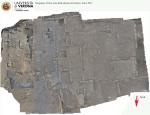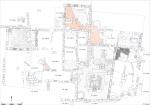Summary (English)
The excavations, begun in 2016, were extended to the west and north. The house was larger than originally thought and its complete extension remains to be discovered. To the north, in sector II.B, a room with a figlinum floor decorated in a pattern of scales was uncovered. Immediately to the south, there were two rooms, the larger of them T-shaped. Inside the larger room, in a second phase, two dividing walls were put in to create three rooms. To the exterior of the east side, there were two rows of macco stone blocks, perhaps a base or reinforcement for the wall.
Further south, was an area characterised by the remains of iron working, a dolium and an amphora, while to the west of the area there was a paving of large blocks of nenfro, steeply sloped, suggesting the presence of a well or collapsed cistern. Proceeding to the west, from north to south, two rooms were identified (partially excavated) and then a rectangular room paved in scutulatum with a diamond motif of white tesserae, adjacent to a room on which the remains of a pipe made of fragmented terracotta segments. Further south, in the south-west corner of the excavation area, the water pipe feeding the well or cistern was identified, and another room of which the south-west corner survived. It was built of opus spicatum, steeply sloping towards the south-west, where a well was situated that had collapsed in antiquity.
In the large room B in sector I, excavated by the Superintendency in 2014, the excavation was deepened in the south-western part where the ancient floor was not preserved. This revealed an earlier scutulatum floor of Hellenistic date.
Lastly, the bottom of the cistern situated next to the fountain was investigated. Once the water was removed, the upper levels of the deposits were excavated. The animal bones and pottery recovered showed that the cistern was used as a midden in the late antique-early medieval periods.
- Attilio Mastrocinque - Università degli Studi di Verona
Director
Team
- Chiara Marchetti - Università di Roma
- Elisa Zentilini - Università di Verona
- Fiammetta Soriano - Università di Verona
- Nicola Luciani - Università di Verona
Research Body
- Università di Verona






![Download [PDF]](/excavation/skins/fasti/images/results/download_sml.png)


